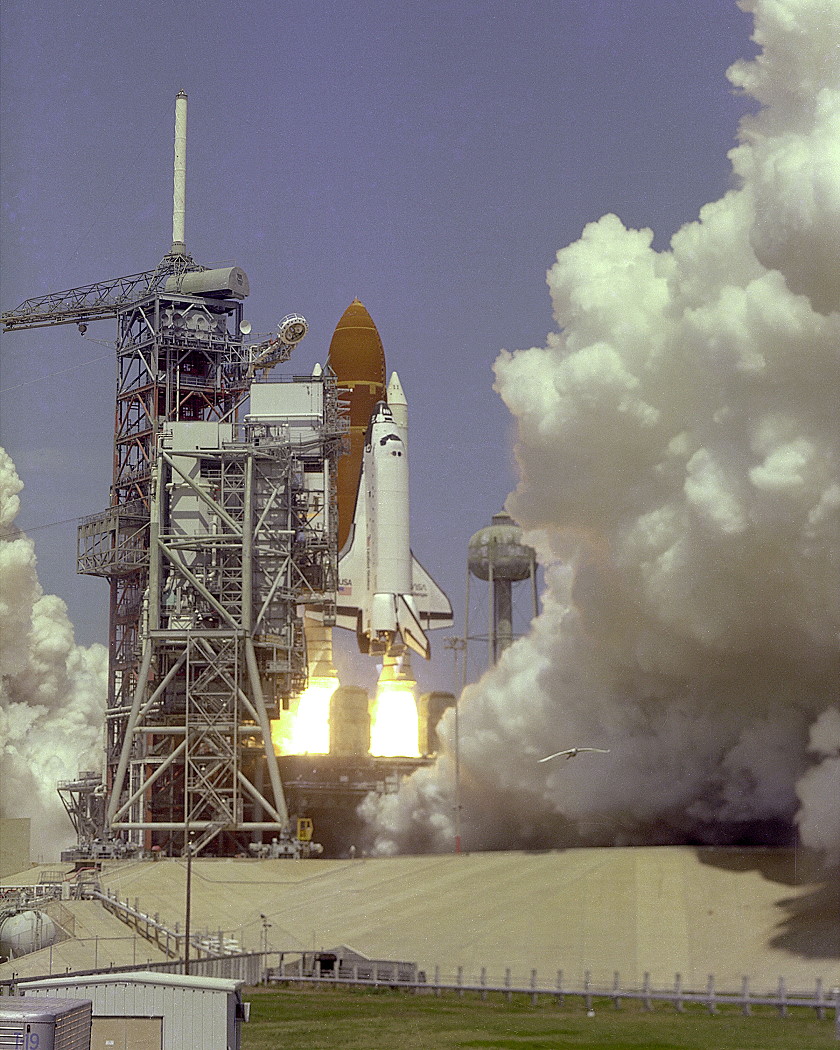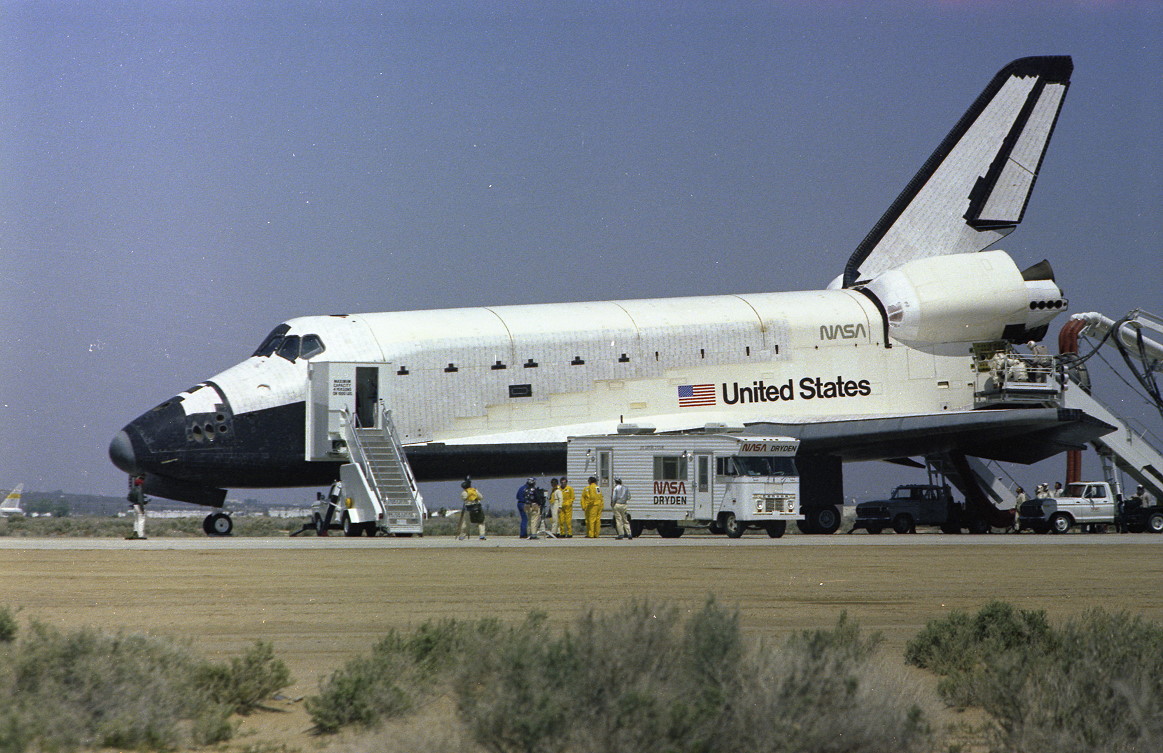35 lat temu 4 kwietnia 1983 roku rozpoczęła się misja
STS-6 Challenger. Byt to pierwszy lot Challengera i jednocześnie drugi lot operacyjny w ramach lotów promów kosmicznych. Załogę stanowiło czterech astronautów , z których niedawno w odstępie kilku miesięcy zmarli
Paul Joseph Weitz oraz
Donald Herod Peterson, Sr.. Pierwotnie start miał nastąpić 20 stycznia. Challenger w odróżnieniu od Columbii był lżejszy , jak również SRB i ET.
W czasie 5-dniowej misji Musgrave i Peterson 7 i 8 kwietnia dokonali pierwszych spacerów kosmicznych w ramach programu STS . Załoga umieściła też na orbicie satelitę telekomunikacyjnego TDRS-1 (Tracking and Data Relay Satellites System). Nieco ponad 2 miesiące po powrocie na Ziemię doszło do kolejnej
historycznej misji orbitalnej tego wahadłowca.


 The First Flight of Space Shuttle Challenger
The First Flight of Space Shuttle ChallengerApril 4, 2018
 STS-6 mission patch (left). STS-6 crew photo (left to right): Donald Peterson, Paul Weitz, Story Musgrave and Karol Bobko (middle). Rollout of Space Shuttle Challenger on a foggy morning in November 1982 (right). Credits: NASA
STS-6 mission patch (left). STS-6 crew photo (left to right): Donald Peterson, Paul Weitz, Story Musgrave and Karol Bobko (middle). Rollout of Space Shuttle Challenger on a foggy morning in November 1982 (right). Credits: NASA35 years ago, first flight of Space Shuttle Challenger
In early 1983, with five flights of the Space Shuttle Columbia successfully completed, NASA prepared to fly its second Orbiter, Challenger, on its maiden voyage. Based on lessons learned, Challenger used a lighter airframe and employed lighter blankets instead of tiles for thermal protection in certain areas of the vehicle, saving 2,486 pounds in overall weight. For additional launch performance, Challenger’s main engines were rated to 104% maximum thrust versus Columbia’s 100%. The maiden flight of Challenger also marked the first use of a lightweight External Tank (ET), weighing about 10,000 pounds less than the tank flown on the first Shuttle flight, and the use of lighter Solid Rocket Booster (SRB) motor casings. All these improvements resulted in an increased payload mass capability.
The primary objective of Challenger’s first mission, STS 6, was to deploy the first in a series of Tracking and Data Relay Satellites (TDRS). The TDRS System, once fully deployed, was a constellation of high-capacity communications satellites in geostationary orbits to provide comprehensive voice and data transmissions between Space Shuttles (and eventually the International Space Station) and Mission Control. Before the TDRS System became operational, communications between the ground and the Shuttle were possible for only about 15 percent of each orbit. The Shuttle would deploy the TDRS satellite mated to an Inertial Upper Stage (IUS), which would boost it from low Earth orbit to geostationary orbit. Another major objective of STS 6 was to conduct the first Extra-Vehicular Activity (EVA) or space walk from the Space Shuttle, and indeed the first US EVA since Skylab in 1974. A variety of science experiments rounded out the five-day mission.
The crew of STS-6 had the distinction of being the oldest crew flown up to that time, with a combined age of 191 years and an average age of nearly 48. Three of the crewmembers had waited fifteen years or more for their first space flight since being selected as astronauts. Commander of STS-6 was Paul J. Weitz, selected in 1966 and a veteran of the 28-day Skylab 2 mission in 1973. Pilot Karol J. Bobko, making his first space flight, was selected in the second group of astronauts for the US Air Force Manned Orbiting Lab (MOL) in 1966 and transferred to NASA in 1969. The two Mission Specialists were F. Story Musgrave, a scientist-astronaut selected in 1967, and Donald H. Peterson, another MOL astronaut transferred to NASA in 1969, both making their first flights.
 Launch of Space Shuttle Challenger on the STS-6 mission (left). Deployment of the TDRS communications satellite on the IUS (middle). Musgrave (left) and Peterson (right) conducting the first Space Shuttle EVA (right). Credits: NASA
Launch of Space Shuttle Challenger on the STS-6 mission (left). Deployment of the TDRS communications satellite on the IUS (middle). Musgrave (left) and Peterson (right) conducting the first Space Shuttle EVA (right). Credits: NASAChallenger arrived at Kennedy Space Center (KSC) on July 5, 1982, and after checkout and mating with its ET and SRBs rolled out to Launch Complex 39A on November 30. Launch of STS-6 occurred April 4, 1983, and about 10 hours into the mission, the crew deployed the TDRS/IUS stack from the cargo bay, successfully completing the primary objective of the flight. Unfortunately, the IUS placed the TDRS into an improperly low orbit, and it took several months of the TDRS using its own fuel to achieve the proper geostationary position. For the next two days, the crew conducted a variety of science experiments and prepared for the EVA on the fourth day. On April 7, wearing the new space suits designed specifically for Space Shuttle EVAs, Musgrave and Peterson floated out of the airlock and into Challenger’s cargo bay. For four hours and 10 minutes, the pair evaluated the mobility of the new suit and practiced various activities in the payload bay before returning to the airlock to end the first Shuttle EVA. On April 9, the crew fired Challenger’s engines to return to Earth, and made a successful landing at Edwards Air Force Base in California, having completed 80 orbits around the Earth in five days and 23 minutes, and traveling 2 million miles. Challenger was ferried back to KSC on April 19, to prepare for its next historic mission, STS-7, in June.
 Musgrave conducting the Continuous Flow Electrophoresis Experiment (CFES) experiment on the middeck of the Space Shuttle Challenger (left). Space Shuttle Challenger lands at Edward AFB to end the STS-6 mission (right). Credits: NASAhttps://www.nasa.gov/mediacast/the-first-flight-of-space-shuttle-challenger30 Years Since STS-6: The Rise of the Challenger (Part 1)
Musgrave conducting the Continuous Flow Electrophoresis Experiment (CFES) experiment on the middeck of the Space Shuttle Challenger (left). Space Shuttle Challenger lands at Edward AFB to end the STS-6 mission (right). Credits: NASAhttps://www.nasa.gov/mediacast/the-first-flight-of-space-shuttle-challenger30 Years Since STS-6: The Rise of the Challenger (Part 1)By Ben Evans April 6th, 2013
(...) Since the original contracts for the shuttle were signed in July 1972, virtually all components were tested to handle significant stress. Limited computing power meant that it was difficult to predict mechanical and thermal loads, and NASA built STA-99 as an engineering tool. After its completion in February 1978, it was tested for a year in a steel rig at Lockheed’s Plant 42 in Palmdale, Calif., where conditions of launch, ascent, orbital flight, re-entry, and landing were simulated. The decision to modify STA-99 as a “real” orbiter came about because, unlike Enterprise, it was an incomplete airframe and could be more easily upgraded. Traditionally, manned spacecraft had been tested to 140 percent of their design strength, but NASA engineers recognized that this might cause so much damage to STA-99 as to make it inadvisable to do so. Consequently, Tom Moser and his team at the Johnson Space Center in Houston, Texas, developed an analytical computer model to simulate 3,000 measurement points on the airframe. Their results confirmed that it could easily withstand 140 percent loads, with actual stress distributions in critical areas comparing favorably with pre-test data.
On 29 January 1979, it was official. Under a $1.9 billion contract between NASA and Rockwell International, STA-99 would follow Columbia as the second orbiter. Four days later, on 2 February, the structural test article was renamed “Challenger,” in honor of a steam-assisted Royal Navy corvette, which undertook a prolonged cruise from December 1872 until May 1876. In support of this expedition, all but two of Challenger’s guns were removed and her spars reduced to increase the availability of space for laboratories, additional cabins, and a special dredging platform. Equipped with specimen jars, alcohol to preserve samples, microscopes and chemical apparatus, thermometers, sounding leads, and sediment collectors, the 80,000-mile Challenger Expedition gathered the equivalent of 50 volumes of information about the Atlantic and Pacific Oceans. Sadly, she was broken up for her copper bottom in 1921 and, today, nothing, save her figurehead remains; this is enshrined in the National Oceanography Centre in Southampton, England. (...)
http://www.americaspace.com/2013/04/06/30-years-since-sts-6-the-rise-of-the-challenger-part-1/30 Years Since STS-6: The Mission of the 'Geritol Bunch' (Part 2)By Ben Evans April 7th, 2013
(...) At another point during the spacewalk, in what NASA labeled a “high metabolic period,” Peterson received a “high O2 usage” warning on his chest display. Although the message cleared quickly and did not recur, it was attributed to flexure within the suit and his high work rate. “I stopped and said ‘I’ve got an alarm’,” Peterson recalled. “Story stopped what he was doing and came over. We were trying to check what was going on and the seal popped back in place and the leak stopped. Now, in those days, we didn’t have constant contact with the ground. They weren’t watching at the time that happened. By the time we dumped the data from the computers to the ground that showed the leak, we were back inside the orbiter.” It seemed that Peterson’s alarm was caused by overworking and breathing excessively rapidly; this depleted his oxygen, forced a higher feed level, and triggered the warning. Biomedical data confirmed that his heart rate was around 192 beats per minute whilst cranking the wrench, but Peterson doubted he could have worked so hard as to breathe enough oxygen to set off the alarm. In spite of the problems, both Musgrave and Peterson clearly savored the opportunity to venture outside the vehicle in orbit.
After returning to the airlock, the data on Peterson’s alarm was pored over by flight controllers with dismay. “They were upset about it,” he said later, and, this being the suit’s first outing in space, the astronauts would almost certainly have been directed back to the airlock had the problem occurred whilst in communication with Mission Control. At the time of STS-6, however, the shuttle still relied heavily on a network of ground stations to relay its communications and data traffic during part of each orbit, typically only 20 percent. It was therefore ironic that on STS-6, which, in Peterson’s mind, benefitted from having gaps in communications with the ground, the first in a series of huge Tracking and Data Relay Satellites (TDRS) had been deployed to improve communications with future shuttle crews. It was optimistically hoped that, after the launch of a second, identical satellite on STS-8 later in 1983, it would be possible to talk to crews not only during the majority of their orbital time, but also throughout re-entry, eliminating the radio blackout normally experienced during this phase of the mission. Moreover, the existing network of 20-year-old ground stations, which were capable of supporting barely one or two spacecraft at a time, could be retired to save money. Once in place, the TDRS network was expected to be capable of supporting the shuttle and up to 26 other satellites simultaneously.
So it was that the men of STS-6—notwithstanding their ages—contributed enormously to the future of the shuttle program and the future of NASA’s space exploration program. For without Musgrave and Peterson’s EVA, the increasingly complex future steps in spacewalking, such as the repair of Solar Max, the servicing of the Hubble Space Telescope, and the assembly of today’s International Space Station, would have been rendered far more difficult. Without TDRS, the crews of the shuttle and station would be severely limited in their ability to transmit voice and data back to Earth … as would numerous other critical scientific satellites in orbit. The “Geritol Bunch” opened up the shuttle’s capabilities to three decades of remarkable accomplishment … and set humanity on a path to the future. (...)
http://www.americaspace.com/2013/04/07/30-years-since-sts-6-the-mission-of-the-geritol-bunch-part-2/https://www.nasa.gov/mission_pages/shuttle/shuttlemissions/archives/sts-6.htmlhttp://www.spacefacts.de/english/bio_ast.htmhttps://en.wikipedia.org/wiki/STS-6